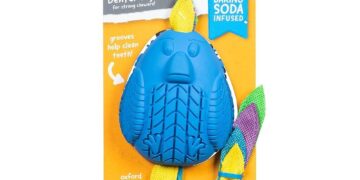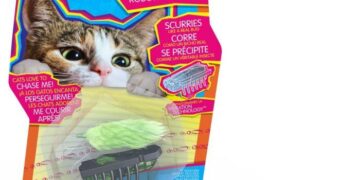Table of Contents
My official title is Veterinary Behaviorist.
For years, I’ve helped clients navigate the complex world of animal behavior, armed with a deep understanding of developmental science and clinical experience.
But last spring, my professional expertise felt utterly useless.
The reason was a tiny, ten-week-old ginger kitten named Leo, who had turned my home into his personal chew-topia and my hands into his favorite teething rings.
He was a tiny shark in a fluffy orange suit.
Despite a mountain of “best-selling” kitten toys I’d bought, Leo’s targets remained my laptop cord, the corner of my favorite wool sweater, and my unsuspecting ankles.
I was doing everything by the book, yet I was failing.
The standard advice wasn’t working, and the frustration was mounting.
If a vet behaviorist armed with textbooks and clinical knowledge was struggling this much, I realized there had to be a fundamental secret about kitten teething that we were all missing.
This journey—from a frazzled kitten parent back to a behaviorist with a new perspective—led me to an epiphany that changed everything.
It’s not just about giving a kitten something to chew; it’s about understanding why they chew and fulfilling the deep sensory needs that drive them.
In a Nutshell: The Sensory Solution for Teething Kittens
For those of you currently wrestling with your own tiny shark, here are the immediate takeaways.
The key to surviving kitten teething is to stop thinking about a single “best toy” and start building a “sensory toolkit.” The most effective approach addresses a kitten’s four critical sensory needs: Texture, Temperature, Scent, and Sound.
- The Core Thesis: A teething kitten is a tiny sensory detective, using its mouth to soothe discomfort and explore its world. Your job is to provide a rotating toolkit of safe, satisfying sensory inputs to meet its changing needs.
- Top 3 Quick Picks to Start Your Toolkit:
- For Soothing Sore Gums: Petstages Dental Kitty Chew Wheel. Its varied textures and rubbery material are perfect for gentle gnawing, and it can be chilled in the refrigerator for extra relief.
- For Redirecting Nipping: A Silvervine Stick. This natural wood stick provides a firm, satisfying texture for intense chewing and releases a scent that is often more potent than catnip, making it irresistible.
- For Dental Health & Play: Petstages Catnip Plaque Away Pretzel. The unique mesh netting helps scrape away soft plaque, while the catnip scent and engaging shape encourage positive chewing habits during playtime.
Part 1: Why “Standard Advice” on Kitten Teething Fails Us
Before we can understand the solution, we have to correctly diagnose the problem.
The veterinary science behind teething is clear and consistent, but the practical advice given to owners often creates a knowledge gap that leaves both kittens and their humans frustrated.
The Teething Process: A Veterinary Primer
Kitten teething happens in two distinct phases.
It’s a marathon, not a sprint, and understanding the timeline is the first step to managing it.
- The Teething Timeline: Kittens are born toothless. Their first set of 26 deciduous (or “milk”) teeth begin to erupt between 2 to 4 weeks of age.1 This is a normal and crucial part of their development that aids in weaning. The main event, and the one that causes the most noticeable chewing behavior, occurs when those baby teeth start to fall out around 3 to 4 months old to make way for their 30 permanent adult teeth. This process is typically complete by the time a kitten is 6 to 7 months old, though for some it can take up to 9 months.2
- Recognizing the Symptoms: During this period, you will likely notice a shift in your kitten’s behavior. These signs are almost always normal and are simply indicators of the discomfort they are experiencing:
- Increased chewing and gnawing on anything and everything.4
- Mild drooling.6
- Slight bleeding from the gums, which you might notice as tiny blood spots on toys or in their food bowl.1
- General crankiness or irritability.3
- Pawing at their mouth or shaking their head.1
- A temporary decrease in appetite, especially for hard kibble, because chewing can be uncomfortable.2
- When to Call the Vet: While teething is a natural process, a few symptoms warrant a professional consultation. Contact your veterinarian if you observe excessive bleeding, a complete refusal to eat for more than a day, persistent bad breath (which could signal an infection), or if you notice adult teeth growing in alongside baby teeth that haven’t fallen out, creating a “double row” of teeth.1
My Key Failure Story: The Box of Failed Toys
Armed with this clinical knowledge, I thought I was prepared for Leo.
I went online and bought a collection of highly-rated toys: hard nylon bones marketed for “aggressive chewers,” durable plastic rings, and other items that promised to withstand a kitten’s dental onslaught.
The result was what I now call the “Box of Failed Toys.”
Leo sniffed them, batted them once, and went right back to chewing the soft rubber of my phone charger.
The hard plastic was completely unappealing and, as I later reflected, potentially too hard for his delicate kitten teeth.8
The shapes were clunky and unengaging for a predator designed to hunt mice, not gnaw on a bone like a puppy.
They lacked any sensory attractants—no interesting scent, no satisfying texture, no rewarding sound.
My mistake was a common one: I was applying dog-centric teething solutions to a cat.
And I realized that the standard veterinary advice, while medically sound, often stops at “provide soft toys to chew on”.2
This advice isn’t wrong, but it’s incomplete.
It tells owners
what to do but fails to provide a framework for how to do it effectively.
This lack of a guiding principle is why so many of us end up with our own “Box of Failed Toys,” feeling like we’ve done something wrong when, in reality, the advice itself was missing a crucial dimension.
Part 2: My Epiphany: A Teething Kitten Isn’t a Dog, It’s a Tiny Sensory Detective
The breakthrough came late one night.
I was watching Leo, who had completely ignored a brand-new, expensive plastic chew toy, meticulously gnawing on the corner of a thick wool blanket.
He wasn’t just trying to destroy it; he was exploring it with his mouth.
I could see him testing the pressure, feeling the texture, enjoying the gentle “give” of the fabric against his sore gums.
It was a full sensory experience.
That’s when it hit me.
I was thinking about the problem all wrong.
My goal had been to stop a behavior—to prevent Leo from chewing on the wrong things.
The real solution was to fulfill the underlying sensory need that was driving the behavior in the first place.
This immediately brought to mind my studies on sensory integration therapy in early childhood development.
In this field, children who are over- or under-sensitive to stimuli are given specific, targeted sensory inputs—tactile, oral-motor, proprioceptive—to help regulate their nervous systems and behaviors.
A child who chews on their shirt collar isn’t being “bad”; they are seeking oral-motor input to calm themselves.
I realized a teething kitten is doing the exact same thing.
It’s a tiny “sensory detective” trying to solve the puzzle of its own discomfort and make sense of its environment through its mouth.
This reframed the entire issue for me and, I hope, for you.
- Old View: “My kitten is being destructive and needs to be stopped.” This is a problem-focused mindset that leads to frustration and discipline.
- New Paradigm: “My kitten is seeking specific sensory input. My job is to provide a safe and satisfying way for them to get it.” This is a solution-focused mindset that fosters empathy, understanding, and effective problem-solving.
This shift turns you from a frustrated disciplinarian into a supportive guide.
You are no longer fighting your kitten’s instincts; you are working with them.
Part 3: The Sensory Engagement Framework: My 4-Point System for the Perfect Teething Toy
This epiphany led me to develop what I call the Sensory Engagement Framework—a four-point system for building a comprehensive teething toolkit.
Instead of searching for one magic toy, you curate a small arsenal that can meet your kitten’s needs as they change from day to day, or even hour to hour.
1. Texture Tier List: The Language of the Gums
A single texture is never enough.
A teething kitten needs variety to satisfy different levels of discomfort and chewing intensity.
- Soft Plush/Fabric: Ideal for days when gums are particularly sore. This texture mimics the feel of prey and provides gentle, comforting pressure. Think soft, cuddly toys that are still durable enough for light gnawing.11
- Dental Mesh/Netting: This is a fantastic texture for both soothing and cleaning. The woven material has a satisfying “give” that massages the gums and helps scrape away soft tartar and plaque as the kitten chews.11
- Soft Rubber/Silicone: This material provides firm but gentle resistance, perfect for a more intense chew session. It’s also the ideal material for chilling. Crucially, it must be soft enough that you can leave an indent with your fingernail; anything harder risks damaging their teeth.9
- Natural Fibers (Sisal, Wool, Cotton): These organic textures are often highly appealing to cats. They are durable and provide a unique mouthfeel that can keep a kitten engaged longer than synthetic materials.15
- Natural Wood (Silvervine/Matatabi Sticks): For the most intense chewing urges, these sticks are a game-changer. They offer a hard, fibrous texture that helps exfoliate teeth safely. Unlike dangerous cooked bones or splintery sticks from the yard, these are designed to be gnawed without splintering into hazardous shards.13
2. The Temperature Dial: Soothing the Fire
Just as with a teething baby, cold can have a wonderful analgesic effect on a kitten’s inflamed gums.
- The “Don’t Freeze” Rule: This is a critical safety point. Toys or cloths should be chilled in the refrigerator, not the freezer. Items frozen solid can become rock-hard, creating a significant risk of fracturing a kitten’s delicate deciduous or incoming adult teeth.9
- DIY Solutions: You don’t need to spend a lot of money to provide cold relief. A simple, clean washcloth, dampened with water, knotted, and chilled in the fridge is a highly effective and safe option.6 You can also make ice cubes from low-sodium, onion-free chicken broth or diluted tuna juice for them to lick and bat around.2
- Commercial Options: Look for toys made from soft rubber or silicone that are specifically designed to be chilled. The Petstages Dental Kitty Chew Wheel is a perfect example.5
3. Scent & Sound Spectrum: The Art of Redirection
This is how you make the “right” toys more appealing than your leather shoes or electrical cords.
You have to out-compete the environment.
- Scent Attractants: Catnip is the classic, but don’t overlook its powerful cousin, silvervine (also known as matatabi). A significant percentage of cats who don’t react to catnip will have a strong, euphoric reaction to silvervine, broadening your options for luring them to an appropriate toy.13 These scents make the toy an object of intense, positive focus.
- Engaging Sounds: Sounds like crinkling materials or a gentle, soft bell are highly effective because they mimic the rustle and movement of prey. This activates a kitten’s innate hunting instincts, drawing their attention and energy toward the toy and away from your furniture.12
4. The Safety Imperative: A Non-Negotiable Checklist
This is the foundation upon which all other choices must be built.
An unsafe toy is not an option, no matter how appealing.
- Choking & Ingestion Hazards: Vigorously inspect every toy. Avoid anything with small, glued-on parts like plastic eyes or noses. Remove any ribbons, weak strings, or feathers that could be easily chewed off and swallowed, as these can cause life-threatening intestinal blockages.9
- Material Toxicity: Choose toys made from known, non-toxic, pet-safe materials. Natural options like organic cotton, wool, and untreated wood are excellent choices.15 Be wary of cheap, generic plastic toys that may contain harmful chemicals like phthalates or BPA.17
- Durability & Supervision: No toy is indestructible. Supervise your kitten during playtime, especially with new toys. Inspect their teething toys daily for any signs of damage, such as cracks, tears, or pieces breaking off. Discard any damaged toy immediately.8
- The “Fingernail Test”: As mentioned before, but it bears repeating: for any chew toy that isn’t fabric, press your fingernail into the surface. If you can’t make a slight indentation, it is too hard for a kitten’s mouth and should be avoided.9
Part 4: The Ultimate Kitten Teething Toy Arsenal (My Vet-Approved Picks)
Using the Sensory Engagement Framework, you can now move from guessing to making strategic choices.
The following table and reviews are not just a list of products, but a curated arsenal designed to provide you with the right tool for any teething situation.
The Vet-Approved Kitten Teething Toy Matrix
| Toy Name | Primary Sensory Feature | Best For | Key Safety Note |
| Petstages Dental Kitty Chew Wheel | Texture / Temperature | Sore Gums, Gentle Chewing | Chill in the fridge, not freezer. Supervise to ensure ribbons aren’t ingested or chewed off.9 |
| Meowy Jane Silvervine Sticks | Scent / Texture | Aggressive Chewers, Redirecting Biting | Natural and safe, but monitor for any potential splintering and discard when the stick becomes small enough to swallow.14 |
| KONG Kitten Toy | Texture / Interactive | Gentle Chewing, Mental Stimulation | Soft rubber is safe. Can be stuffed with a small amount of wet food and chilled for added enrichment and soothing.18 |
| Petstages Catnip Plaque Away Pretzel | Texture / Scent | Daily Dental Health, Playful Nipping | Mesh is effective for cleaning but should be inspected regularly for fraying, holes, or other signs of wear.12 |
Detailed Reviews: Building Your Toolkit
Best for Soothing Sore Gums (Temperature & Soft Texture)
- Petstages Dental Kitty Chew Wheel: This is a top-tier choice for general soothing. The rubbery ring provides a satisfying chew, while the fabric streamers add interest. Its key feature is that it can be safely chilled in the refrigerator to provide cool relief to inflamed gums.11
- KONG Kitten Toy: The kitten version of the classic KONG is made from a softer rubber that’s perfect for delicate mouths. Its durability stands up to persistent gnawing, and its real value comes from its versatility. Stuff it with a bit of your kitten’s wet food and chill it for a long-lasting, soothing treat that also provides mental enrichment.14
Best for Dental Cleaning (Mesh & Abrasive Textures)
- Petstages Catnip Plaque Away Pretzel: The pretzel shape allows kittens to get a good grip from multiple angles. The standout feature is the durable mesh netting that covers the toy. As a kitten chews, this netting gently scrapes their teeth, helping to remove soft plaque before it can harden into tartar.12
- Catstages Dental Kitty Chew Mice: These combine multiple sensory attractions. They are lightweight and perfect for batting around, filled with catnip to encourage play, and covered in that same effective dental mesh to help clean teeth with every bite.12
Best for Heavy Chewers & Redirecting Biting (Durable & Scented)
- Silvervine/Matatabi Sticks: When your kitten has a powerful urge to chew, these are the perfect outlet. They are essentially sticks of dried, unprocessed silvervine plant, which is completely safe for cats. The fibrous wood provides a tough, satisfying texture that endures heavy chewing, and the natural scent is a powerful attractant for redirection.13
- Yeowww! Catnip Banana: A cult classic for a reason. This toy is made from a highly durable cotton twill fabric that can withstand a surprising amount of abuse. More importantly, it is packed only with 100% potent, organically grown catnip, making it one of the most powerfully scented toys on the market and a fantastic tool for redirecting a nipping kitten.17
Best for Interactive Play & Distraction
- KONG Kickeroo Kitten Toy: This long, plush toy is designed to appeal to a cat’s instinct to grab prey with its front paws and kick with its powerful hind legs. Providing a “kicker” toy like this gives your kitten a healthy outlet for this behavior, saving your hands and arms from being the target during play.12
- Frisco Moppy Ball: This toy is a sensory delight. The soft, dangly “moppy” chenille noodles offer a unique texture that’s great for carrying, while the lightweight design makes it perfect for batting and chasing. It’s a simple, effective toy for burning off that frenetic kitten energy.22
Conclusion: From Teething Terror to Happy Hunter
My journey with Leo came to a happy resolution.
By using the Sensory Engagement Framework, I assembled a small, strategic toolkit of toys.
When I saw him pawing at his mouth, I knew his gums were sore and offered him the chilled KONG from the fridge.
When he got that wild look in his eye and started stalking my feet, I would toss him a silvervine stick to satisfy his urge for an intense chew.
During our evening play sessions, the mesh pretzel became our go-to for interactive fun that also cleaned his teeth.
The frantic, destructive chewing didn’t just stop—it was channeled into positive, appropriate outlets.
My hands were saved, my sweater was spared, and my bond with Leo grew stronger.
The teething phase can be challenging, but it is a temporary and essential part of your kitten’s development.1
It’s an opportunity not just to survive, but to learn your kitten’s unique language and needs.
By shifting your perspective from that of a frustrated owner to an empathetic sensory guide, you can transform this difficult period into a foundation for a lifetime of positive play, good dental health, and a deep, trusting relationship with your happy, healthy companion.
Works cited
- Kitten Teething Complete Guide: Signs, Symptoms & How to Help – Greencross Vets, accessed August 17, 2025, https://www.greencrossvets.com.au/services/kitten-teething/
- Kitten Teething: What You Need to Know | Elk Grove Vets – Bruceville Pet Hospital, accessed August 17, 2025, https://www.brucevilleph.com/site/blog/2024/05/31/kitten-teething
- Kitten teething: What cat caretakers should know – Monroe Veterinary Clinic, accessed August 17, 2025, https://www.monroeveterinaryclinic.com/site/blog/2022/03/30/kitten-teething-what-cat-caretakers-should-know
- Kitten Teething: Everything You Need to Know – Purina, accessed August 17, 2025, https://www.purina.com/articles/cat/kitten/health/kitten-teething
- How to Help a Teething Kitten – Blue Buffalo, accessed August 17, 2025, https://www.bluebuffalo.com/articles/cat/tips-to-survive-kitten-teething/
- Kitten Teething: Symptoms &Treatment | Zoetis Petcare, accessed August 17, 2025, https://www.zoetispetcare.com/blog/article/kitten-teething
- Kitten Teething: What You Need to Know | O’Fallon Vets – Gentle Doctor Animal Hospital, accessed August 17, 2025, https://www.gentledranimalhospital.com/site/blog/2024/06/30/kitten-teething
- Kitten Teething: Age Timeline, Signs & How You Can Help – Hill’s Pet Nutrition, accessed August 17, 2025, https://www.hillspet.com/cat-care/behavior-appearance/kitten-teething
- Losing baby teeth: an owner’s guide to kitten teething – Vetster, accessed August 17, 2025, https://vetster.com/en/wellness/losing-baby-teeth-an-owner-s-guide-to-kitten-teething
- Kitten Teething: Everything You Need to Know | Mechanicsburg Vets, accessed August 17, 2025, https://www.silverspringsanimalclinic.com/site/blog/2022/08/30/kitten-teething
- The 5 Best Kitten Teething Toys for Tiny Chewers – Basepaws, accessed August 17, 2025, https://basepaws.com/cat-insider/the-5-best-kitten-teething-toys-for-tiny-chewers
- 16 Best Kitten Teething Toys in Webster, TX – Advanced Pet Care of Clear Lake, accessed August 17, 2025, https://advancedpetcareofclearlake.com/blog/kitten-teething-toys-webster-tx/
- The 9 Best Kitten Teething Toys To Keep Your Tiny Tiger Out Of Trouble – Rover.com, accessed August 17, 2025, https://www.rover.com/blog/best-kitten-teething-toys/
- The 10 Best Chew Toys for Cats, accessed August 17, 2025, https://cats.com/best-cat-chew-toys
- Why Are Organic and Natural Cat Toys Best for My Cat? – Koston, accessed August 17, 2025, https://koston.com/blogs/editorial/why-organic-and-natural-cat-toys-best
- Safe and Fun Cat Toys – Oregon Humane Society, accessed August 17, 2025, https://www.oregonhumane.org/wp-content/uploads/8.3.17_Cat_Toys.pdf
- How to pick safe(r) kitten toys – ManyPets, accessed August 17, 2025, https://manypets.com/us/blog/safe-kitten-toys/
- Cat has a chewing problem. Recommendations for chewy toys that might help me replace a “no” with a “yes”? – Reddit, accessed August 17, 2025, https://www.reddit.com/r/CatAdvice/comments/18b3yc8/cat_has_a_chewing_problem_recommendations_for/
- Kitten teething: a survival guide | ManyPets, accessed August 17, 2025, https://manypets.com/us/blog/kitten-teething/
- Signs Your Kitten Is Teething and What To Do | Rock Springs Vets, accessed August 17, 2025, https://www.mountainaireanimalclinic.com/site/blog/2022/06/15/signs-your-kitten-teething
- The Best Chew Toys For Cats – YouTube, accessed August 17, 2025, https://www.youtube.com/watch?v=xaE5QNdAzAI
- The 16 Best Kitten Toys for a Fun, Safe Playtime – Cats.com, accessed August 17, 2025, https://cats.com/best-kitten-toys
- Soothing Teething Toys for Cats and Dogs – PetPlace.com, accessed August 17, 2025, https://www.petplace.com/article/general/pet-care/teething-toys-cat-dogs
- A guide to choosing the perfect dog or cat chew toy – 24Petwatch Canada, accessed August 17, 2025, https://www.24petwatch.com/ca/blog/dog-and-cat-chew-toys-for-an-amazing-time
- 10 Best Cat Chew Toys 2025: According to Reviews | Chewy, accessed August 17, 2025, https://www.chewy.com/best/cat-chew-toys_s112568
- Kitten Toys: Teething, Interactive & More (Free Shipping) – Chewy, accessed August 17, 2025, https://www.chewy.com/b/toys-2297






